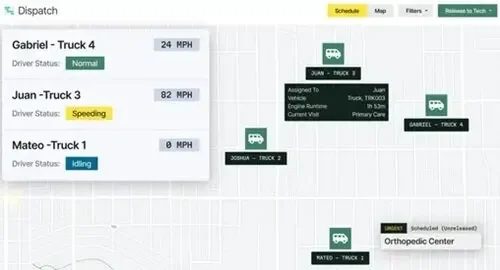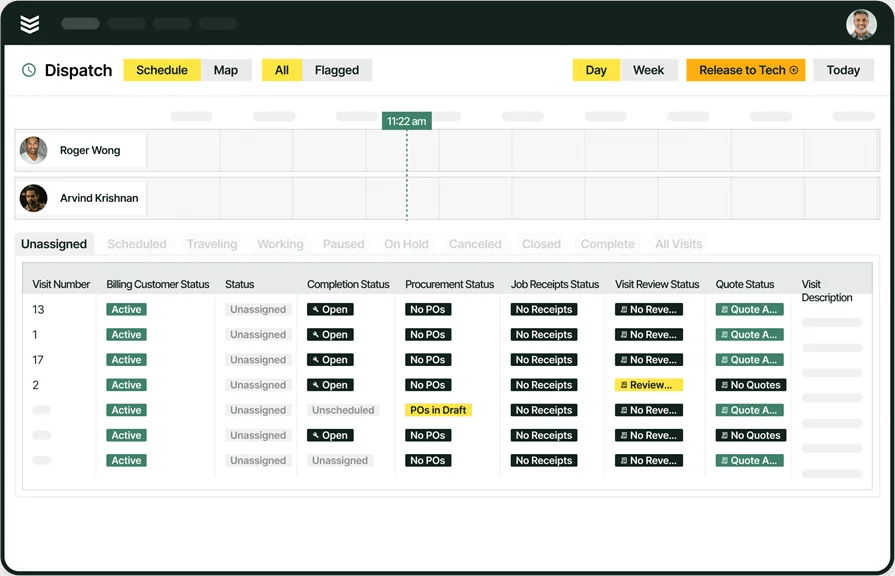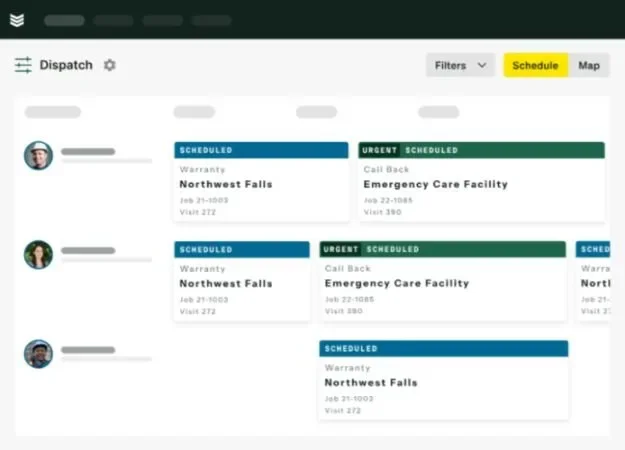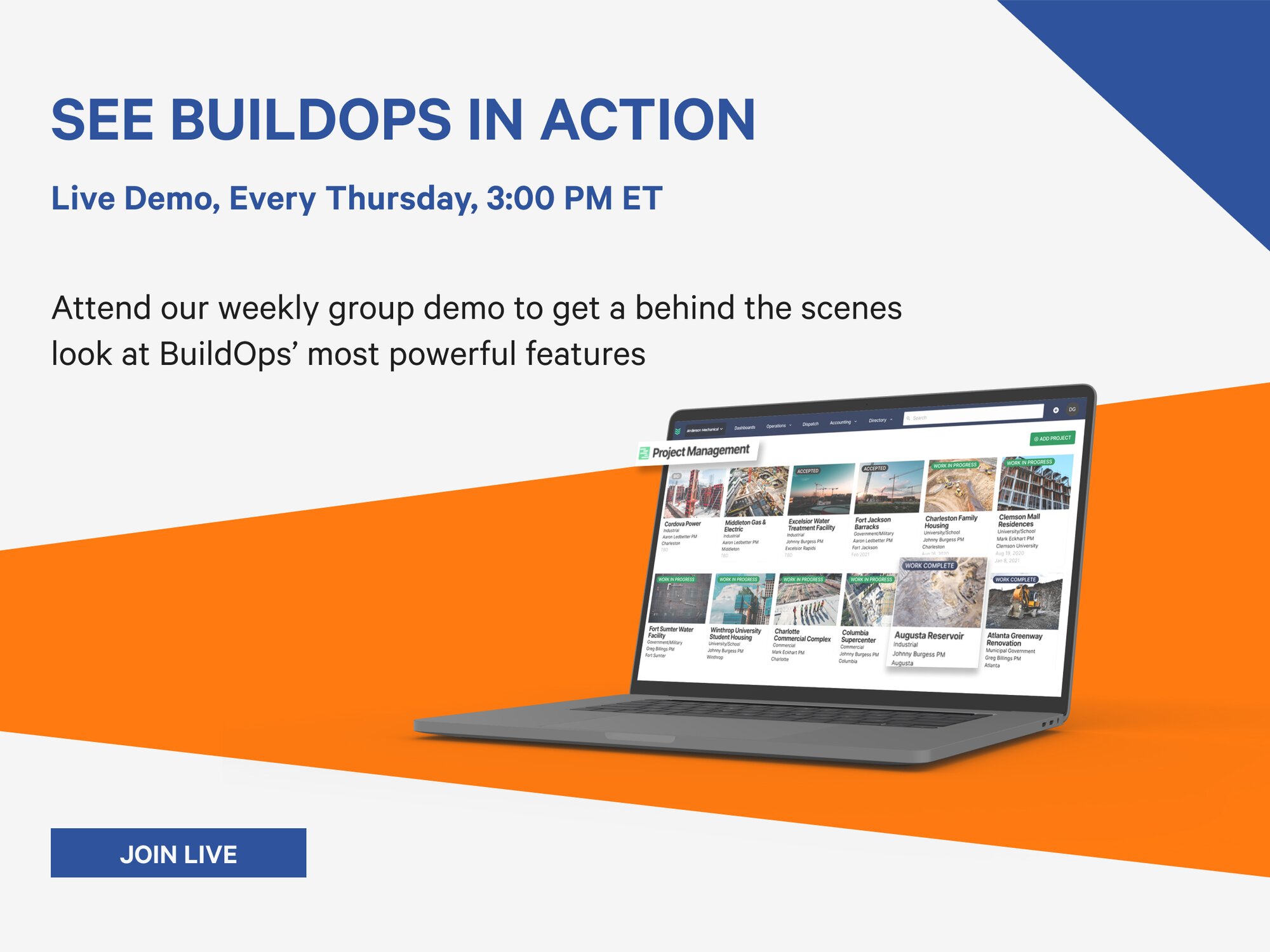Managing crews in the field takes precision. Contractors running field service jobs—whether HVAC, plumbing, or electrical—deal with shifting schedules, urgent repairs, and technicians spread across locations. Dispatch management keeps that chaos in check. It’s the core of keeping jobs on track, techs informed, and customers satisfied.
When you’ve got systems tied together with strong field service management, you gain control over how work gets assigned and completed. This guide covers what matters to field service contractors looking to run dispatch like a well-oiled machine.
- The essentials of dispatch management in field services
- How field service dispatch management for contractors works
- 7 benefits of automating dispatch management for your contracting business
- 10 dispatch management best practices for contractors in field services
- 3 best dispatch management tools for contractors
Getting your team where they need to be, with the tools and info they need, starts with dispatch field service management that actually fits the way contractors work. Let’s dig into the basics and unpack why dispatch management is such a critical part of every job.
The essentials of dispatch management in field services
Contractors in field services need to know where their crews are, what jobs are lined up, and how long each task takes. Dispatch management handles that. It assigns jobs, tracks field teams, and keeps schedules accurate. When handled right, it reduces delays, missed calls, and wasted hours.
What is dispatch management for contractors in field service?
Dispatch management is how field service contractors schedule, assign, and monitor field service jobs. It matches available technicians to job requirements, prioritizes tasks, and plans routes. This keeps crews on time and jobs moving across multiple locations without confusion or downtime.
For field service contractors, this means having a system that handles job volume, urgent calls, and technician gaps. It connects the office with field crews using real-time data—who’s free, where they are, what tools they need. Without dispatch management, tasks fall through, time is lost, and customer trust drops.
Why dispatch field service management is so important for contractors
Dispatch field service management gives contractors full control over how jobs are assigned, tracked, and completed. It connects incoming requests with technician availability, making it possible to schedule based on skillset, location, and urgency. It also lets the office monitor job status in real time—who’s on-site, what stage the job is in, and whether the work is progressing as expected. Without this, teams rely on guesswork, which leads to double-booking, missed appointments, and unnecessary delays.
A proper system also centralizes job details, customer history, and asset data in one place. That means techs get everything they need—work orders, site notes, part lists—before heading out. Updates from the field flow directly back to the office, so billing, reporting, and follow-ups happen without delay. This reduces the number of return visits, improves technician output, and makes it easier to handle more jobs with the same crew. In short, it’s how contractors maintain control when juggling high-volume, fast-paced work.
How field service dispatch management for contractors works
Contractors handling field work need a repeatable process for dispatching. It’s not just about sending techs out—it’s about syncing job demand with crew capacity, timing, and tools. Strong dispatch field service management runs on consistency, not guesswork.
1. Gather incoming job requests
Every dispatch starts with a service request. This could come from a customer call, email, or through your CRM. The key is centralizing those requests so nothing slips through. Make sure your team records key details: location, job type, required skills, and any urgency.
When done right, this step gives dispatchers the context they need to route work effectively. It also helps field service teams avoid confusion or overlap. Strong systems like field service manager software help streamline this intake process, giving visibility into all open jobs.
2. Review technician availability
Before assigning any task, dispatchers need to know who’s available, where they are, and what they’re qualified to do. This step pulls together skill sets, job proximity, and current workloads.
A live dispatch board or digital schedule can show gaps or overloads. Contractors relying on this step prevent scheduling mistakes and reduce technician downtime. It also supports better workforce distribution—especially during peak seasons or when managing emergency calls.
3. Prioritize and schedule jobs
Some jobs can wait. Others need immediate attention. This step is where urgency meets resource availability. Use job tags, SLA requirements, and customer preferences to rank tasks.
Effective scheduling ties job type to technician skill and availability. If this breaks down, missed appointments and return visits pile up. Tools that handle field service scheduling allow teams to match jobs with the right person at the right time, without overcomplicating the workflow.
4. Dispatch technicians with job details
Once jobs are assigned, techs need to know where they’re going, when to be there, and what to bring. That includes job notes, customer instructions, asset history, and parts lists.
Sending a tech out with incomplete info sets up delays or failed visits. Instead, send job details through mobile dispatch tools so nothing gets lost. At this step, communication is key—techs should be able to ask questions before rolling out.

Explore our dispatching tool
Coordinate communication and keep projects running smoothly and on time.
5. Monitor job status and field updates
Job progress shouldn’t be a guessing game. Dispatchers should know when a tech has arrived, started, and completed the work. Updates from the field help track time spent, issues found, or jobs that require a follow-up.
This step depends on real-time visibility. Using tools with built-in field service metrics and KPIs lets managers track what’s happening in the field without making constant calls. It also flags jobs that are falling behind or need escalation.
6. Record job data and reporting
After the job is complete, everything needs to be logged—photos, notes, time logs, and customer feedback. This data isn’t just for billing. It fuels performance tracking, warranty records, and team accountability.
Having a strong field service reporting setup lets contractors turn job history into insights. It also supports audits, helps verify job completion, and strengthens long-term customer service.
7 benefits of automating dispatch management for your contracting business
Manual dispatching creates gaps. Calls get missed, jobs overlap, and your crew spends more time waiting than working. Automating dispatch management solves that. It connects schedules, tracks performance, and routes jobs without needing someone to piece everything together by hand. When used right, it simplifies daily workload while raising job completion rates.
1. Faster response times
Automation cuts the time between job requests and dispatch decisions. Instead of flipping through whiteboards or spreadsheets, requests get routed to available techs immediately. With tools that support field service routing, jobs are assigned based on location, traffic, and tech availability—helping crews arrive sooner.
2. Better visibility into technician status
With an automated system, dispatchers can view where techs are, what jobs they’re on, and how far along they are. This real-time insight helps avoid double-booking or assigning techs already tied up. It also makes rerouting simple when priorities shift.
3. Reduced scheduling errors
Automation removes the guesswork in matching jobs to techs. The system checks availability, skill sets, and current workloads to create balanced schedules. This prevents overbooking or gaps in job coverage—especially during peak demand.
4. Cleaner, centralized data
Every job interaction gets logged automatically. From arrival time to job notes, automation tracks it all. With integrated field service ticketing systems, everything stays linked to the job file—making it easier to audit, invoice, and reference.
5. Clearer performance tracking
Automated systems feed data into your reporting tools. This helps you track how long jobs take, how many get completed per tech, and where delays come from. With field service dashboards, you can see patterns and act on them without digging through reports.
6. Easier scaling
As your crew grows, manual dispatching hits its limits. Automation handles dozens—or hundreds—of jobs at once. It makes it easier to add new techs, take on new work, and manage larger fleets without losing control of the schedule.
7. Improved customer satisfaction
Fewer missed appointments, quicker job completions, and accurate arrival windows help build trust with customers. They don’t need to chase updates or wonder when the tech will show up. Automation brings consistency, and that consistency improves client experience.
10 dispatch management best practices for contractors in field services
Field service dispatch management depends on precision, repeatability, and the ability to shift fast. Contractors running daily operations across HVAC, plumbing, electrical, and other service trades know that one missed job or misrouted technician can knock out an entire day. These ten best practices help you build a stronger dispatch core—one that scales with your crew, improves accountability, and keeps schedules tight.
1. Use a dynamic scheduler
Job requests change by the hour. Cancellations, emergencies, and delays are part of the job. A dynamic field service scheduler allows dispatchers to shift jobs on the fly without losing visibility of the overall workload. This helps ensure your highest-priority jobs get addressed first, even as the day unfolds unpredictably.
2. Track every step of the workflow
From customer intake to technician check-out, every step should be accounted for. If your process doesn’t include job timestamps, notes, and outcomes, your team has blind spots. A clear field service management process workflow helps avoid dropped tasks, missing updates, and inconsistent job tracking. This reduces rework and keeps your crew accountable.
3. Keep real-time visibility on crews
Without knowing where your techs are or what status their jobs are in, your dispatch decisions will fall short. Real-time location tracking combined with job status updates gives dispatchers the data they need to adapt the schedule on the fly. Integrated field service operations software helps monitor field movement, check on progress, and reroute techs with minimal downtime.
4. Automate booking and confirmations
Manual job booking burns time and often leads to backlogs. With field service booking software, requests can be logged, scheduled, and confirmed without a phone call or email. This improves response speed and reduces errors from hand-entered scheduling. It also improves your team's ability to handle incoming volume during busy weeks.
5. Set clear job requirements upfront
If a technician arrives without knowing the job scope, they risk bringing the wrong tools or wasting time confirming details. Dispatch tickets should clearly list service type, tools required, location details, contact information, and any special access needs. The better the prep, the fewer return visits or mid-job interruptions. This also reduces tech frustration and helps protect margins.
6. Optimize routes using mapping tools
Fuel and drive time eat into profit if your techs zigzag between job sites. Planning routes manually often leads to inefficient days. With field service mapping software, dispatchers get route options that factor in location clustering, traffic, and road closures. Optimized routing supports faster job turnover and less wear on vehicles.
7. Group jobs by skillset and tools
Every tech has different strengths—some handle installs, others focus on service calls. Dispatchers should categorize incoming jobs by the skills or certifications needed. Assigning work based on experience helps reduce callbacks and boosts first-time fix rates. It also lets techs stay focused on what they do best instead of losing time on work outside their wheelhouse.
8. Balance workloads across your team
An overloaded tech falls behind, while underused techs leave productivity on the table. Look at daily and weekly assignments to ensure jobs are spread across the crew based on availability and location. Review field performance to spot imbalances early. Balanced dispatching keeps burnout low and throughput high—especially during surge periods.
9. Keep historical job data accessible
Repeat work without history leads to wasted time. Technicians need quick access to past service notes, part usage, and customer preferences. Storing everything in your field service analytics platform makes data easy to access in the field. This shortens diagnostic time and helps techs handle follow-up work confidently.
10. Build systems, not just schedules
Schedules change—but systems keep the work steady. Instead of relying on individual memory or habits, build a standardized approach to job intake, dispatching, routing, and feedback collection. Your systems should be documented, repeatable, and supported by tools that reduce manual steps. This makes your team more resilient and able to deliver consistent service, no matter how packed the calendar gets.
3 best dispatch management tools for contractors
Contractors need more than just a calendar to keep jobs moving. Dispatch management tools built for field service go beyond basic scheduling—they connect the back office with the field, track technician performance, and centralize all job data. The best tools support fast job turnover, fewer delays, and better communication across your crew. Choosing software that fits your workflow can cut admin time and keep your team focused on the work, not the paperwork.
6 key features to look for in field service dispatch management software
The best dispatch software doesn't just schedule jobs—it helps you run the entire day from one place. Look for features that simplify technician coordination and back-office work, while keeping everything connected and visible.
- Scheduling: This feature lets you assign jobs based on availability, skills, and location in real time. With a field service scheduling tool, you can prevent overlap, reroute techs fast, and keep jobs on pace without manual updates.
- CRM: A CRM system stores every customer interaction, job history, and service request in one place. It helps your team access the full picture before every visit, leading to faster resolutions and fewer repeat calls.
- Tech mobile app: Your field crew needs access to schedules, job details, and checklists without calling the office. A strong technician mobile app keeps everyone on the same page and lets techs update jobs from the field without delays.
- Fleet management: Know where your trucks are, what condition they’re in, and how they’re being used. A fleet tracking system helps reduce idle time, supports better route planning, and keeps your assets in working order.
- Invoicing & payments solution: Automating this step speeds up cash flow and reduces billing mistakes. With integrated invoicing and payments, techs can close out jobs in the field, send invoices instantly, and collect payment without waiting days.
In the next section, we’ll break down three top dispatch management platforms and how each one fits different types of contracting businesses—from commercial-focused teams to those handling residential calls.
Top 3 field service dispatch management software for contractors
Every field service business runs a little differently—some handle high-volume commercial work, others serve local homeowners, and some do both. The right dispatch tool should match the way your team operates in the field, not force you to change it. Below are three dispatch software platforms that stand out for different contractor needs, each with strengths, limitations, and unique use cases.
1. Best for commercial: BuildOps
BuildOps is designed specifically for commercial contractors managing multiple crews, properties, and complex job timelines. It offers full visibility into technician availability, job history, and service routes—all tied into a single platform. Everything connects from dispatch to billing, without extra plugins or bolt-ons.
How pricing works: Custom pricing based on company size and deployment needs.
Features beyond dispatching: BuildOps includes a technician mobile app for real-time updates from the field, asset tracking tools to manage equipment and maintenance, and automated workflows that reduce repetitive admin work. It also connects scheduling, CRM, invoicing, and reporting into a single dashboard.
What sets it apart for specialization: BuildOps supports client hierarchies, ideal for contractors who service multiple sites under a single customer. It also tracks complex service agreements and multi-visit jobs with built-in automation, giving commercial contractors a system that matches real-world field operations.

Explore BuildOps dispatching
We help contractors manage all the moving parts in the field—from one place.
2. Best for residential: ServiceTitan
Image Source: ServiceTitan
ServiceTitan offers a wide range of features built for residential service contractors—from job scheduling to customer communication. It includes tools for marketing, estimates, and payment collection, which makes it well-suited for companies working inside homes. However, it may feel bloated for teams focused strictly on field coordination or those running lean commercial crews.
How pricing works: Tiered pricing based on features and user count.
Features beyond dispatching: Includes built-in phone integration, marketing automation, and customer follow-up tools. Techs also get access to a mobile app with job checklists, photos, and time tracking.
What sets it apart for specialization: Designed with residential workflows in mind, ServiceTitan helps office staff and techs manage leads, quotes, and follow-ups in a single view. It’s particularly useful for contractors who also handle customer-facing sales and upselling in the field.
3. Best for general contractors: Dispatch
Image Source: Dispatch.me
Dispatch is focused on helping general contractors coordinate work with third-party service providers and subcontractors. It’s strong on communication and job tracking across different teams, with tools that help streamline updates between office and field. That said, it may not offer the deep project management features needed for larger, long-term construction jobs.
How pricing works: Subscription-based pricing with plans depending on number of users and features.
Features beyond dispatching: Dispatch offers real-time status tracking, client messaging tools, and branded customer experiences that keep everyone in the loop. It’s useful for managing job requests across multiple vendors.
What sets it apart for specialization: General contractors who work with a network of subcontractors benefit from Dispatch’s centralized communication tools and oversight features. It creates transparency between all parties without requiring complex setup.
Wrapping up dispatch management comes down to one thing: control. Contractors working in field service need more than a whiteboard and good memory to keep jobs flowing. From scheduling to routing to technician tracking, every part of the process demands accuracy and flexibility. The features we’ve covered—from mobile access to fleet tracking—can transform how contractors move through the day. But most platforms out there don’t offer this full range in one place. That’s where BuildOps makes a difference—built with commercial service teams in mind, it combines dispatching, scheduling, invoicing, and reporting into a system that mirrors how real field crews operate.

See how BuildOps works
Find out exactly how we help you manage field dispatching from start to finish.








